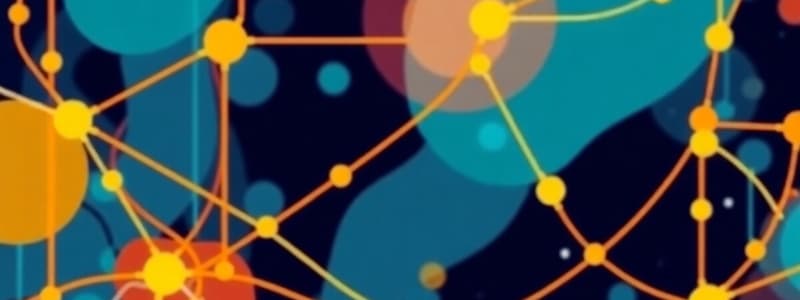Podcast
Questions and Answers
What is the primary function of a router in a network?
What is the primary function of a router in a network?
- To forward data packets between different networks. (correct)
- To filter and prevent unauthorized access to the network.
- To convert digital signals to analog for transmission.
- To connect multiple devices within a local area network.
Which type of database system uses structured query language (SQL) for data manipulation?
Which type of database system uses structured query language (SQL) for data manipulation?
- Object-oriented databases.
- Relational databases. (correct)
- Hierarchical databases.
- NoSQL databases.
What is a primary characteristic of object-oriented programming?
What is a primary characteristic of object-oriented programming?
- Use of objects to encapsulate data and behavior. (correct)
- Reliance on functional programming techniques.
- Emphasis on procedures and functions.
- Focus on the sequence of actions performed.
Which phase is NOT part of the Software Development Life Cycle (SDLC)?
Which phase is NOT part of the Software Development Life Cycle (SDLC)?
Which of the following represents a difference between HTTP and HTTPS?
Which of the following represents a difference between HTTP and HTTPS?
Which of the following data structures operates on a Last In First Out (LIFO) principle?
Which of the following data structures operates on a Last In First Out (LIFO) principle?
Which of the following is a common key concept in the design of a relational database?
Which of the following is a common key concept in the design of a relational database?
In the context of version control, what is the purpose of branching?
In the context of version control, what is the purpose of branching?
Flashcards are hidden until you start studying
Study Notes
BCA Study Notes
Networking
- Definition: Interconnection of computers to share resources and information.
- Key Concepts:
- OSI Model: 7 layers - Physical, Data Link, Network, Transport, Session, Presentation, Application.
- Protocols: TCP/IP, HTTP, FTP, SMTP.
- Networking Devices: Routers, Switches, Hubs, Modems.
- Networking Types: LAN, WAN, MAN, PAN.
- IP Addressing: IPv4 vs IPv6, Subnetting, DHCP.
Database Management
- Definition: System for storing, retrieving, and managing data.
- Key Concepts:
- DBMS Types: Relational (SQL), NoSQL, Object-oriented.
- Data Models: Entity-Relationship Model, Relational Model.
- SQL: Commands - SELECT, INSERT, UPDATE, DELETE; transactions and normalization.
- Database Design: Schema design, indexing, relationships (one-to-one, one-to-many).
Computer Programming
- Definition: Process of writing code to create software applications.
- Key Concepts:
- Programming Paradigms: Procedural, Object-oriented, Functional.
- Languages: C, C++, Java, Python.
- Data Structures: Arrays, Linked Lists, Stacks, Queues, Trees, Hash Tables.
- Algorithms: Sorting (Quick, Merge), Searching (Binary Search), Complexity (Big O notation).
Software Engineering
- Definition: Application of engineering principles to software development.
- Key Concepts:
- Software Development Life Cycle (SDLC): Phases - Requirement analysis, Design, Implementation, Testing, Maintenance.
- Models: Waterfall, Agile, Iterative, Spiral.
- Testing: Unit testing, Integration testing, System testing, Acceptance testing.
- Version Control: Git, SVN, branching, merging.
Web Development
- Definition: Creation of websites and web applications.
- Key Concepts:
- Frontend Technologies: HTML, CSS, JavaScript; frameworks (React, Angular, Vue).
- Backend Technologies: Server-side languages (Node.js, PHP, Ruby, Python); frameworks (Express, Django).
- Databases: Integration with front-end and back-end (using SQL databases or NoSQL).
- Web Protocols: HTTP, HTTPS, RESTful APIs, WebSockets.
AI/ML
- Definition: Artificial Intelligence (AI) and Machine Learning (ML) involve creating systems that can perform tasks requiring human intelligence.
- Key Concepts:
- AI Techniques: Natural Language Processing, Computer Vision, Expert Systems.
- ML Algorithms: Supervised learning (regression, classification), Unsupervised learning (clustering), Reinforcement learning.
- Tools & Libraries: TensorFlow, PyTorch, Scikit-Learn, Keras.
- Data Preparation: Data cleaning, normalization, training/testing splits.
Networking
- Interconnection of computers: Sharing resources and information
- OSI Model: 7 layers for communication - Physical, Data Link, Network, Transport, Session, Presentation, Application
- Common protocols: TCP/IP for internet communication, HTTP for web browsing, FTP for file transfer, SMTP for email
- Networking devices:
- Routers: Direct traffic between networks
- Switches: Forward data to specific devices on a network
- Hubs: Broadcast data to all devices on a network
- Modems: Modulate/demodulate signals for internet connections
- Networking types:
- LAN (Local Area Network): Connects devices within a small area
- WAN (Wide Area Network): Connects devices over a large geographical area
- MAN (Metropolitan Area Network): Connects devices within a city or region
- PAN (Personal Area Network): Connects devices within a small personal space
- IP Addressing: Unique address for each device on a network
- IPv4: Older version, using 32-bit addresses
- IPv6: Newer version, using 128-bit addresses, addressing the shortage of IPs
- Subnetting: Dividing a network into smaller subnetworks for better management
- DHCP (Dynamic Host Configuration Protocol): Assigning IP addresses automatically
Database Management
- System for storing, retrieving and managing data
- DBMS Types:
- Relational (SQL): Stores data in tables with relationships, uses structured query language (SQL) for data manipulation
- NoSQL: More flexible for unstructured data, supports various data models
- Object-oriented: Stores data as objects with properties and methods
- Data Models:
- Entity-Relationship Model: Describes relationships between entities
- Relational Model: Represents data in tables with rows and columns
- SQL: Standard language for querying and managing relational databases
- Commands: SELECT (retrieve data), INSERT (add data), UPDATE (modify data), DELETE (remove data)
- Transactions: Series of operations treated as a single unit, ensuring data consistency
- Normalization: Organizing data to reduce redundancy and improve data integrity
- Database Design: Planning and creating the structure of a database to meet specific needs
- Schema Design: Blueprint for defining database tables and relationships
- Indexing: Creating fast lookup structures for speeding up data retrieval
- Relationships: One-to-one, one-to-many, many-to-many
Computer Programming
- Writing code to create software applications
- Programming Paradigms: Approaches to structuring code
- Procedural: Code is executed in a sequential order, following procedures
- Object-oriented: Code is organized into objects that represent real-world entities
- Functional: Code is written in a way that emphasizes functions and avoids side effects
- Popular Programming Languages:
- C: Low-level, fast, and widely used for system programming
- C++: Extension of C, offering object-oriented features, used for various system programming tasks
- Java: Object-oriented, platform-independent, commonly used for web and mobile applications
- Python: High-level, versatile, used for various applications from web development to data science
- Data Structures: Ways to organize data efficiently
- Arrays: Ordered collection of elements stored in contiguous memory locations
- Linked Lists: Linear collection of nodes, each containing data and a reference to the next node
- Stacks: Data structure following Last-In, First-Out (LIFO) principle
- Queues: Data structure following First-In, First-Out (FIFO) principle
- Trees: Hierarchical data structure with a root node and branches
- Hash Tables: Data structure that uses a hash function to map keys to values
- Algorithms: Step-by-step procedures to solve problems
- Sorting: Arranging data in a specific order (e.g., Quick sort, Merge sort)
- Searching: Finding specific elements in a data set (e.g., Binary search)
- Complexity: Measuring the efficiency of algorithms using Big O notation
Software Engineering
- Applying engineering principles to software development
- Software Development Life Cycle (SDLC): Systematic process for software development
- Phases:
- Requirement Analysis: Defining the project scope and user needs
- Design: Creating the blueprint for the software
- Implementation: Writing the code and building the software
- Testing: Ensuring the software meets requirements and is bug-free
- Maintenance: Fixing issues and improving the software over time
- Phases:
- Software Development Models: Different approaches to organizing the SDLC
- Waterfall: Linear, sequential approach where each phase is completed before moving to the next
- Agile: Iterative and incremental, with frequent feedback and adjustments throughout the development process
- Iterative: Developing the software in small, iterative cycles
- Spiral: Iterative approach with risk analysis and prototyping
- Testing: Ensuring software quality and functionality
- Unit testing: Testing individual software components
- Integration testing: Testing the interaction between different software components
- System testing: Testing the complete software system
- Acceptance testing: Testing the software against user requirements
- Version Control: Managing changes to source code over time
- Git: Popular version control system with decentralized approach
- SVN (Subversion): Centralized version control system
- Branching: Creating separate lines of development for new features or bug fixes
- Merging: Combining changes from different branches to a main line
Web Development
- Creating websites and web applications
- Frontend Technologies: User interface of a website
- HTML: Defines the structure and content of a web page
- CSS: Controls the style and appearance of web pages
- JavaScript: Enables interactive and dynamic behavior on web pages
- Frameworks: Libraries of pre-written components to streamline development
- React: Popular JavaScript library for building user interfaces
- Angular: TypeScript-based framework for building complex web applications
- Vue: Progressive framework offering flexibility and scalability
- Backend Technologies: Server-side logic and data management
- Server-side languages:
- Node.js: JavaScript runtime environment for building server-side applications
- PHP: Popular server-side language for dynamic web development
- Ruby: Dynamic language with a focus on simplicity and productivity
- Python: Versatile language used for backend web development
- Frameworks: Sets of tools and libraries to simplify backend development
- Express.js: Minimalist framework for Node.js
- Django: Python framework for rapid web development
- Server-side languages:
- Databases: Storing and managing web application data
- Integration: Connecting front-end and back-end to retrieve and manipulate data
- SQL databases: Relational databases like MySQL, PostgreSQL, Oracle
- NoSQL databases: More flexible for unstructured data like MongoDB, Cassandra
- Web Protocols: Rules and standards governing web communication
- HTTP (Hypertext Transfer Protocol): Protocol for transferring data between web browsers and servers
- HTTPS (Hypertext Transfer Protocol Secure): Secure version of HTTP using encryption
- RESTful APIs (Representational State Transfer): Standard for building web services
- WebSockets: Protocol for real-time two-way communication between web browsers and servers
AI/ML
- Creating systems that can perform tasks requiring human intelligence
- AI Techniques: Approaches to mimicking human intelligence
- Natural Language Processing (NLP): Understanding and processing human language
- Computer Vision: Analyzing and understanding visual information
- Expert Systems: Systems that mimic the decision-making capabilities of human experts
- ML Algorithms: Learning from data to improve performance
- Supervised learning: Training models with labelled data to make predictions
- Regression: Predicting continuous values (e.g., house prices)
- Classification: Categorizing data (e.g., spam detection)
- Unsupervised learning: Discovering patterns in unlabeled data
- Clustering: Grouping similar data points together
- Reinforcement learning: Learning through trial and error, interacting with an environment to achieve goals
- Supervised learning: Training models with labelled data to make predictions
- Tools & Libraries: Software for developing and deploying AI/ML models
- TensorFlow: Popular open-source platform for numerical computation and machine learning
- PyTorch: Python-based machine learning library
- Scikit-learn: Python library for machine learning algorithms and data preprocessing
- Keras: High-level neural network API
- Data Preparation: Preparing data for training and evaluation
- Data cleaning: Removing errors and inconsistencies
- Normalization: Scaling data to a common range
- Training/testing splits: Dividing data into sets for model training and evaluation
Studying That Suits You
Use AI to generate personalized quizzes and flashcards to suit your learning preferences.




